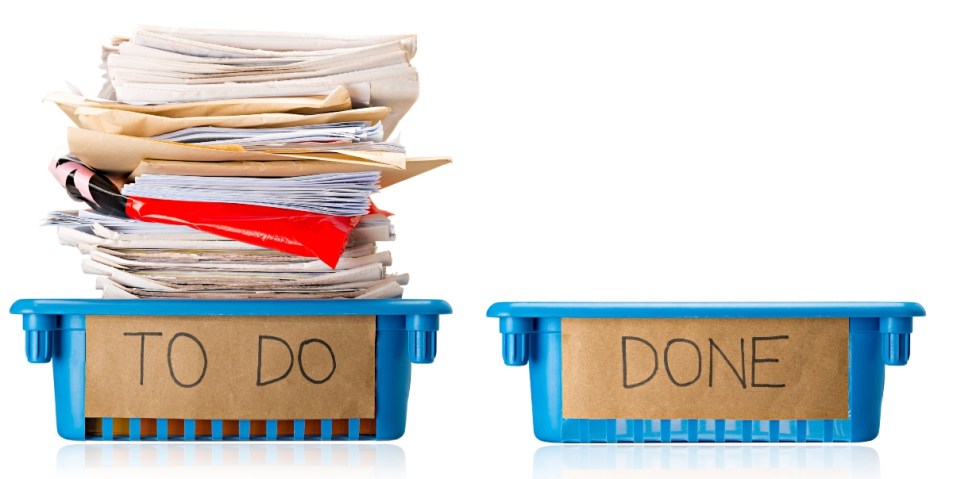Expert Advice: How Do I Stop Procrastinating?
Putting off filing your taxes? Here's how to get back on track.

We’re all guilty of putting things off. Maybe it’s mid-March and you haven’t filed your taxes yet even though you know you should, or you need to get off the couch to go grocery shopping because there’s no food in the house, but you just can’t motivate. Whatever the reason you’re dilly-dallying, there’s no need to beat yourself up. Instead, use tips from our experts to get yourself back on track and stop procrastinating.
Meet our expert panel
- Timothy Pychyl, PhD, author of Solving the Procrastination Puzzle: A Concise Guide to Strategies for Change, is a leading expert on procrastination.
- Katy Milkman, PhD, author of How to Change, is the James G. Dinan Professor at the Wharton School of The University of Pennsylvania.
- Suzanne Degges-White, PhD, chair of the Department of Counseling and Higher Education at Northern Illinois University, studies women’s transitions.
Let Go of Guilt
Tease out the emotions.
The biggest myth about procrastination is that it’s about poor organizational skills. “It’s not a time-management issue, it’s an emotion-management issue,” says expert Timothy Pychyl, PhD. “We tend to put things off because of fear of failure, boredom, or frustration.” If you feel like you can’t do something because it’s too hard, for example, ask yourself, Have I ever done difficult things before? Of course, you have. Or if a project is boring, is there a way to make it more interesting, like collaborating with a loved one? “Once you recognize your emotions, tell yourself, It’s okay to feel this way. This will help you find better ways to cope than procrastinating.”
Forgive yourself.
It’s easy to blame ourselves for postponing a task, but shame keeps us stuck. “Research shows forgiving ourselves by recognizing our ‘common humanity’ — that everyone procrastinates at times, and it’s not our fault — reduces procrastination because we’re more likely to try again when we’re kind to ourselves,” explains Pychyl. “Putting things off is a coping mechanism we all use to help us deal with stress. Just realizing there’s nothing wrong with you helps you take action.”
Pinpoint ‘micro’ steps.
“To move forward, ask yourself, What’s a tiny step I can take right now?” advises Pychyl. “When I’m putting off a difficult conversation, that ‘tiny action’ is simply hitting the answer button on my cell — I don’t think about the call itself.” Or if you’re avoiding a work project or email, the smallest thing you could is simply open your laptop, he says. “Pinpointing the next smallest action builds motivation fast.”
Stay Inspired
Bundle temptations.
One of the best ways to ditch the delays is with “temptation bundling,” or combining a chore with something enjoyable, says expert Katy Milkman, PhD. “For example, exercising while watching your favorite TV show can motivate you to exercise longer.” Another way to make tasks more fun is to make them more social. “If you’re putting off doing your taxes, try doing them with a friend and a bottle of wine.” Temptation bundling is an easy way to help you achieve more.
Try a ‘soft’ commitment.
“A proven way to beat procrastination is by using a ‘commitment device,’ a technique that ties consequences to behaviors,” says Milkman. “Fining yourself money if you don’t quit smoking by a certain date, for instance, is a highly effective way to quit.” A more positive way to hold yourself accountable? “A ‘softer’ commitment device, like publicly committing to a goal on social media, is also effective.”
Celebrate progress.
Taking a moment to enjoy the feeling of making progress curbs procrastination, says expert Suzanne Degges-White, PhD. “Whether you prefer an internal reward, like simply making a check mark after completing each step and patting yourself on the back, or an external reward, like listening to your favorite podcast after you finish a task, marking your journey will keep you moving forward.”
A version of this article originally appeared in our print magazine, Woman’s World.












